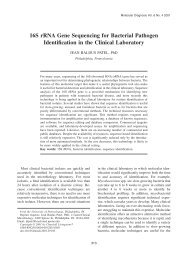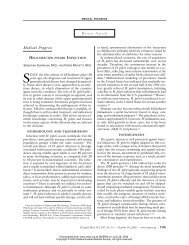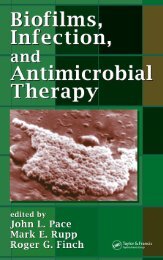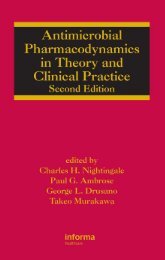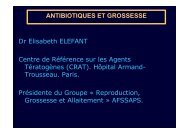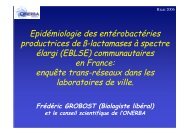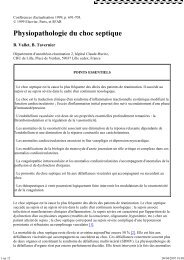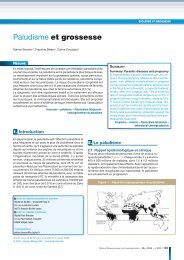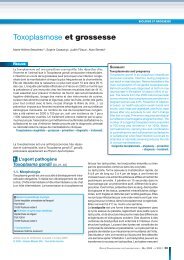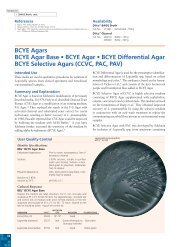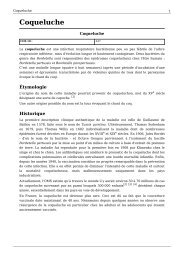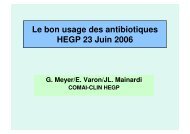- Page 1: Principles and Practice of Clinical
- Page 5 and 6: Principles and Practice of Clinical
- Page 7 and 8: Contents List of Contributors Prefa
- Page 9 and 10: List of Contributors Dlawer A. A. A
- Page 11: Preface Change is inevitable and no
- Page 15 and 16: 1 β-Haemolytic Streptococci Androu
- Page 17 and 18: PATHOGENESIS AND VIRULENCE FACTORS
- Page 19 and 20: EPIDEMIOLOGY OF β-HAEMOLYTIC STREP
- Page 21 and 22: CLINICAL ASPECTS OF β-HAEMOLYTIC S
- Page 23 and 24: LABORATORY DIAGNOSIS AND IDENTIFICA
- Page 25: LABORATORY DIAGNOSIS AND IDENTIFICA
- Page 29 and 30: REFERENCES 17 Courvalin PM, Carlier
- Page 31 and 32: REFERENCES 19 Nelson D, Loomis L, F
- Page 33 and 34: 2 Oral and Other Non-b-Haemolytic S
- Page 35 and 36: INFECTIONS CAUSED BY NON-β-HAEMOLY
- Page 37 and 38: INFECTIONS CAUSED BY NON-β-HAEMOLY
- Page 39 and 40: INFECTIONS CAUSED BY NON-β-HAEMOLY
- Page 41 and 42: INFECTIONS CAUSED BY NON-β-HAEMOLY
- Page 43 and 44: LABORATORY DIAGNOSIS 31 Figure 2.4
- Page 45 and 46: LABORATORY DIAGNOSIS 33 Table 2.8 D
- Page 47 and 48: ANTIBIOTIC SUSCEPTIBILITY 35 Table
- Page 49 and 50: REFERENCES 37 Billington, S.J., Jos
- Page 51: REFERENCES 39 Streptococcus bovis b
- Page 54 and 55: 42 STREPTOCOCCUS PNEUMONIAE infecti
- Page 56 and 57: 44 STREPTOCOCCUS PNEUMONIAE virulen
- Page 58 and 59: 46 STREPTOCOCCUS PNEUMONIAE togethe
- Page 60 and 61: 48 STREPTOCOCCUS PNEUMONIAE and it
- Page 62 and 63: 50 STREPTOCOCCUS PNEUMONIAE of resi
- Page 64 and 65: 52 STREPTOCOCCUS PNEUMONIAE more se
- Page 66 and 67: 54 STREPTOCOCCUS PNEUMONIAE Contrai
- Page 68 and 69: 56 STREPTOCOCCUS PNEUMONIAE Nuermbe
- Page 71 and 72: 4 Enterococcus spp. Esteban C. Nann
- Page 73 and 74: CLINICAL INFECTIONS 61 Another fact
- Page 75 and 76: LABORATORY DIAGNOSIS 63 Table 4.2 T
- Page 77 and 78:
MECHANISMS OF RESISTANCE TO ANTIMIC
- Page 79 and 80:
MANAGEMENT OF ENTEROCOCCAL INFECTIO
- Page 81 and 82:
REFERENCES 69 VRE-positive patients
- Page 83:
REFERENCES 71 Paulsen, I. T., Baner
- Page 86 and 87:
74 STAPHYLOCOCCUS AUREUS gentamicin
- Page 88 and 89:
76 STAPHYLOCOCCUS AUREUS Table 5.2
- Page 90 and 91:
78 Table 5.3 Antibiotic resistance
- Page 92 and 93:
80 STAPHYLOCOCCUS AUREUS of peptido
- Page 94 and 95:
82 STAPHYLOCOCCUS AUREUS newborn in
- Page 96 and 97:
84 STAPHYLOCOCCUS AUREUS Bone and J
- Page 98 and 99:
86 STAPHYLOCOCCUS AUREUS A wide ran
- Page 100 and 101:
88 STAPHYLOCOCCUS AUREUS guidelines
- Page 102 and 103:
90 STAPHYLOCOCCUS AUREUS Boelaert,
- Page 104 and 105:
92 STAPHYLOCOCCUS AUREUS Haggar, A.
- Page 106 and 107:
94 STAPHYLOCOCCUS AUREUS Massey, R.
- Page 108 and 109:
96 STAPHYLOCOCCUS AUREUS Ross, J.I.
- Page 110 and 111:
98 STAPHYLOCOCCUS AUREUS Weisblum,
- Page 112 and 113:
100 Table 6.2 Laboratory characteri
- Page 114 and 115:
102 COAGULASE-NEGATIVE STAPHYLOCOCC
- Page 116 and 117:
104 COAGULASE-NEGATIVE STAPHYLOCOCC
- Page 118 and 119:
106 COAGULASE-NEGATIVE STAPHYLOCOCC
- Page 120 and 121:
108 COAGULASE-NEGATIVE STAPHYLOCOCC
- Page 122 and 123:
110 COAGULASE-NEGATIVE STAPHYLOCOCC
- Page 125:
Section Two Gram-Positive Bacilli
- Page 128 and 129:
116 CORYNEBACTERIUM SPP. The genus
- Page 130 and 131:
% DTP3 coverage 118 CORYNEBACTERIUM
- Page 132 and 133:
120 CORYNEBACTERIUM SPP. the absenc
- Page 134 and 135:
122 CORYNEBACTERIUM SPP. Table 7.2
- Page 136 and 137:
124 CORYNEBACTERIUM SPP. yellowish
- Page 138 and 139:
126 CORYNEBACTERIUM SPP. Colman, G.
- Page 140 and 141:
128 CORYNEBACTERIUM SPP. Schmitt, M
- Page 142 and 143:
130 LISTERIA AND ERYSIPELOTHRIX SPP
- Page 144 and 145:
132 LISTERIA AND ERYSIPELOTHRIX SPP
- Page 146 and 147:
134 LISTERIA AND ERYSIPELOTHRIX SPP
- Page 148 and 149:
136 LISTERIA AND ERYSIPELOTHRIX SPP
- Page 150 and 151:
138 LISTERIA AND ERYSIPELOTHRIX SPP
- Page 152 and 153:
140 BACILLUS SPP. AND RELATED GENER
- Page 154 and 155:
142 BACILLUS SPP. AND RELATED GENER
- Page 156 and 157:
144 BACILLUS SPP. AND RELATED GENER
- Page 158 and 159:
146 BACILLUS SPP. AND RELATED GENER
- Page 160 and 161:
148 BACILLUS SPP. AND RELATED GENER
- Page 162 and 163:
150 BACILLUS SPP. AND RELATED GENER
- Page 164 and 165:
152 BACILLUS SPP. AND RELATED GENER
- Page 166 and 167:
154 BACILLUS SPP. AND RELATED GENER
- Page 168 and 169:
156 BACILLUS SPP. AND RELATED GENER
- Page 170 and 171:
158 BACILLUS SPP. AND RELATED GENER
- Page 172 and 173:
160 MYCOBACTERIUM TUBERCULOSIS they
- Page 174 and 175:
162 MYCOBACTERIUM TUBERCULOSIS The
- Page 176 and 177:
164 MYCOBACTERIUM TUBERCULOSIS An i
- Page 178 and 179:
166 MYCOBACTERIUM TUBERCULOSIS trea
- Page 180 and 181:
168 MYCOBACTERIUM TUBERCULOSIS Hobb
- Page 183 and 184:
11 Non-Tuberculosis Mycobacteria St
- Page 185 and 186:
MYCOBACTERIUM AVIUM-INTRACELLULARE
- Page 187 and 188:
MYCOBACTERIUM XENOPI 175 et al. 198
- Page 189 and 190:
RAPID GROWING MYCOBACTERIA 177 laye
- Page 191 and 192:
REFERENCES 179 OTHER NON-TUBERCULOS
- Page 193:
REFERENCES 181 Tunkel, D. E. and Ro
- Page 196 and 197:
184 AEROBIC ACTINOMYCETES and treha
- Page 198 and 199:
186 AEROBIC ACTINOMYCETES Sabouraud
- Page 200 and 201:
188 AEROBIC ACTINOMYCETES Georghiou
- Page 203 and 204:
13 Moraxella catarrhalis and Kingel
- Page 205 and 206:
KINGELLA KINGAE-MEDIATED DISEASES I
- Page 207 and 208:
ANTIMICROBIAL SUSCEPTIBILITY 195 la
- Page 209 and 210:
IMMUNITY 197 VIRULENCE In general,
- Page 211 and 212:
REFERENCES 199 Ahmed, K., Rikitomi,
- Page 213 and 214:
REFERENCES 201 Hager, H., Verghese,
- Page 215 and 216:
REFERENCES 203 Samukawa, T., Yamana
- Page 217 and 218:
14 Neisseria meningitidis Dlawer A.
- Page 219 and 220:
THE CELL ENVELOPE: ANATOMY, HETEROG
- Page 221 and 222:
PATHOGENESIS 209 a sialyl donor. LO
- Page 223 and 224:
CLINICAL MANIFESTATIONS 211 The Sou
- Page 225 and 226:
LABORATORY DIAGNOSIS 213 poor progn
- Page 227 and 228:
MANAGEMENT 215 recommended for empi
- Page 229 and 230:
PREVENTION AND CONTROL 217 incorpor
- Page 231 and 232:
REFERENCES 219 Caugant, D.A., Froho
- Page 233 and 234:
15 Neisseria gonorrhoeae Catherine
- Page 235 and 236:
LABORATORY DIAGNOSIS 223 predominan
- Page 237 and 238:
LABORATORY DIAGNOSIS 225 In an atte
- Page 239 and 240:
MANAGEMENT OF INFECTION 227 region
- Page 241 and 242:
REFERENCES 229 Fenton, K.A., Ison,
- Page 243 and 244:
16 Acinetobacter spp. Peter Hawkey
- Page 245 and 246:
ACINETOBACTER 233 have identified m
- Page 247 and 248:
CLINICAL FEATURES OF ACINETOBACTER
- Page 249 and 250:
TREATMENT 237 reported in the medic
- Page 251 and 252:
CHRYSEOBACTERIUM (PREVIOUSLY FLAVOB
- Page 253 and 254:
REFERENCES 241 ofloxacin) (Mensah,
- Page 255 and 256:
REFERENCES 243 Husni RN, Goldstein
- Page 257 and 258:
17 Haemophilus spp. Derrick W. Croo
- Page 259 and 260:
EPIDEMIOLOGY 247 routinely used in
- Page 261 and 262:
PREVENTION AND CONTROL 249 flaring
- Page 263:
REFERENCES 251 Peltola, H. (2000) W
- Page 266 and 267:
254 BORDETELLA SPP. Table 18.2 Viru
- Page 268 and 269:
256 BORDETELLA SPP. superfamily and
- Page 270 and 271:
258 BORDETELLA SPP. diagnosis of pe
- Page 272 and 273:
260 BORDETELLA SPP. vaccines (Edwar
- Page 274 and 275:
262 BORDETELLA SPP. Gordon, J.E. an
- Page 276 and 277:
264 BORDETELLA SPP. Schaeffer, L.M.
- Page 278 and 279:
266 BRUCELLA SPP. Table 19.2 Charac
- Page 280 and 281:
268 BRUCELLA SPP. Periplasmic Prote
- Page 282 and 283:
270 BRUCELLA SPP. Although no singl
- Page 285 and 286:
20 Actinobacillus actinomycetemcomi
- Page 287 and 288:
PATHOGENICITY 275 flp-1 flp-2 orfB
- Page 289 and 290:
TREATMENT AND MANAGEMENT 277 presen
- Page 291:
REFERENCES 279 Lepine, G., Caudry,
- Page 294 and 295:
282 FRANCISELLA TULARENSIS similar
- Page 296 and 297:
284 FRANCISELLA TULARENSIS Saslaw,
- Page 298 and 299:
286 RICKETTSIA SPP. that manifest t
- Page 300 and 301:
288 RICKETTSIA SPP. develop into sh
- Page 302 and 303:
290 RICKETTSIA SPP. onto sheep or h
- Page 304 and 305:
292 RICKETTSIA SPP. the specific de
- Page 306 and 307:
294 RICKETTSIA SPP. Olson, J. G., B
- Page 308 and 309:
296 BARTONELLA SPP. Table 23.1 Spec
- Page 310 and 311:
298 BARTONELLA SPP. The term quinta
- Page 312 and 313:
300 BARTONELLA SPP. study showing t
- Page 314 and 315:
302 BARTONELLA SPP. Fournier PE, Ma
- Page 316 and 317:
304 BARTONELLA SPP. Spaulding WB, H
- Page 318 and 319:
306 MYCOPLASMA SPP. described rarel
- Page 320 and 321:
308 MYCOPLASMA SPP. Genital Mycopla
- Page 322 and 323:
310 MYCOPLASMA SPP. Specimens Speci
- Page 324 and 325:
312 MYCOPLASMA SPP. antigens in com
- Page 326 and 327:
314 MYCOPLASMA SPP. Macrolides are
- Page 329 and 330:
25 Chlamydia spp. and Related Organ
- Page 331 and 332:
DESCRIPTION OF THE ORGANISM 319 C.
- Page 333 and 334:
CLINICAL FEATURES 321 leave shallow
- Page 335 and 336:
LABORATORY DIAGNOSIS 323 aetiologic
- Page 337 and 338:
MANAGEMENT 325 some merit in screen
- Page 339 and 340:
REFERENCES 327 Chlamydia trachomati
- Page 341 and 342:
26 Tropheryma whipplei F. Fenollar
- Page 343 and 344:
DESCRIPTION OF THE ORGANISM 331 81
- Page 345 and 346:
IMMUNOLOGY AND PATHOLOGY 333 EPIDEM
- Page 347 and 348:
DIAGNOSIS 335 The manifestations co
- Page 349 and 350:
REFERENCES 337 Serology The recent
- Page 351 and 352:
REFERENCES 339 Lepidi, H., Costedoa
- Page 353 and 354:
27 Identification of Enterobacteria
- Page 355 and 356:
343 Table 27.3 Biochemical reaction
- Page 357:
REFERENCES 345 Bacterial identifica
- Page 360 and 361:
348 ESCHERICHIA COLI AND SHIGELLA S
- Page 362 and 363:
350 ESCHERICHIA COLI AND SHIGELLA S
- Page 364 and 365:
352 ESCHERICHIA COLI AND SHIGELLA S
- Page 366 and 367:
354 ESCHERICHIA COLI AND SHIGELLA S
- Page 368 and 369:
356 ESCHERICHIA COLI AND SHIGELLA S
- Page 370 and 371:
358 ESCHERICHIA COLI AND SHIGELLA S
- Page 372 and 373:
360 ESCHERICHIA COLI AND SHIGELLA S
- Page 374 and 375:
362 ESCHERICHIA COLI AND SHIGELLA S
- Page 376 and 377:
364 ESCHERICHIA COLI AND SHIGELLA S
- Page 379 and 380:
29 Salmonella spp. Claire Jenkins 1
- Page 381 and 382:
EPIDEMIOLOGY 369 Lab reports (1000s
- Page 383 and 384:
LABORATORY DIAGNOSIS 371 complicati
- Page 385 and 386:
PREVENTION AND CONTROL 373 two prob
- Page 387 and 388:
REFERENCES 375 Duthie, R. and Frenc
- Page 389 and 390:
30 Klebsiella, Citrobacter, Enterob
- Page 391 and 392:
PATHOGENICITY 379 Capsule A key cha
- Page 393 and 394:
PATHOGENESIS 381 Pneumonia due to K
- Page 395 and 396:
EPIDEMIOLOGY AND INFECTIONS 383 pro
- Page 397 and 398:
REFERENCES 385 Cooke, E.M., Sazegar
- Page 399 and 400:
31 Donovanosis and Klebsiella spp.
- Page 401:
REFERENCES 389 Kharsany, A.B., Hoos
- Page 404 and 405:
392 PROTEUS, PROVIDENCIA AND MORGAN
- Page 406 and 407:
394 PROTEUS, PROVIDENCIA AND MORGAN
- Page 408 and 409:
396 PROTEUS, PROVIDENCIA AND MORGAN
- Page 410 and 411:
398 YERSINIA SPP. infected. Yersini
- Page 412 and 413:
400 YERSINIA SPP. Figure 33.2 The n
- Page 414 and 415:
402 YERSINIA SPP. fever is a childh
- Page 416 and 417:
404 YERSINIA SPP. REFERENCES Abdel-
- Page 418 and 419:
406 YERSINIA SPP. Wauters, G., Kand
- Page 420 and 421:
408 VIBRIO SPP. Genus Definition Th
- Page 422 and 423:
410 VIBRIO SPP. Heat-shock reaction
- Page 424 and 425:
412 VIBRIO SPP. It has long been as
- Page 426 and 427:
414 VIBRIO SPP. Most of the strains
- Page 428 and 429:
416 VIBRIO SPP. produced by the met
- Page 431 and 432:
35 Aeromonas and Plesiomonas spp. A
- Page 433 and 434:
CLINICAL FEATURES 421 O-antigen LPS
- Page 435 and 436:
LABORATORY DIAGNOSIS 423 spp., have
- Page 437 and 438:
REFERENCES 425 can also produce chr
- Page 439 and 440:
36 Pseudomonas and Burkholderia spp
- Page 441 and 442:
PATHOGENICITY 429 organism from the
- Page 443 and 444:
INFECTIONS DUE TO P. AERUGINOSA 431
- Page 445 and 446:
ANTIBIOTIC RESISTANCE AND THERAPY 4
- Page 447 and 448:
EPIDEMIOLOGY 435 P. aeruginosa. Var
- Page 449 and 450:
PATHOGENESIS AND INFECTION 437 type
- Page 451 and 452:
ANTIBIOTIC SUSCEPTIBILITY AND TREAT
- Page 453 and 454:
REFERENCES 441 specimens from CF pa
- Page 455:
REFERENCES 443 therapy for sepsis i
- Page 458 and 459:
446 LEGIONELLA SPP. Table 37.1 Legi
- Page 460 and 461:
448 LEGIONELLA SPP. numerous other
- Page 462 and 463:
450 LEGIONELLA SPP. DIAGNOSTIC METH
- Page 464 and 465:
452 LEGIONELLA SPP. antigens such a
- Page 466 and 467:
454 LEGIONELLA SPP. Dournon, E. (19
- Page 468 and 469:
456 LEGIONELLA SPP. Petitjean, F.,
- Page 470 and 471:
458 COXIELLA BURNETII been reported
- Page 472 and 473:
460 COXIELLA BURNETII Laughlin, T.,
- Page 475 and 476:
39 Leptospira spp. P. N. Levett Sas
- Page 477 and 478:
CLINICAL FEATURES 465 only the most
- Page 479 and 480:
MANAGEMENT 467 Molecular Typing Pul
- Page 481 and 482:
REFERENCES 469 CONTROL Control and
- Page 483:
REFERENCES 471 World Health Organiz
- Page 486 and 487:
474 HELICOBACTER SPP. AND RELATED O
- Page 488 and 489:
476 HELICOBACTER SPP. AND RELATED O
- Page 490 and 491:
478 HELICOBACTER SPP. AND RELATED O
- Page 492 and 493:
480 HELICOBACTER SPP. AND RELATED O
- Page 494 and 495:
482 HELICOBACTER SPP. AND RELATED O
- Page 497 and 498:
41 Campylobacter and Arcobacter spp
- Page 499 and 500:
PROPERTIES OF THE FAMILY CAMPYLOBAC
- Page 501 and 502:
PROPERTIES OF THE FAMILY CAMPYLOBAC
- Page 503 and 504:
PROPERTIES OF THE FAMILY CAMPYLOBAC
- Page 505 and 506:
ANIMAL PATHOGENS AND COMMENSAL CAMP
- Page 507 and 508:
THE GENUS ARCOBACTER 495 Table 41.4
- Page 509 and 510:
REFERENCES 497 at the CDC it was co
- Page 511 and 512:
REFERENCES 499 Karmali, M.A., Skirr
- Page 513 and 514:
REFERENCES 501 conservative re-trea
- Page 515 and 516:
42 Treponemes Andrew J. L. Turner M
- Page 517 and 518:
EPIDEMIOLOGY 505 thought to be a su
- Page 519 and 520:
LABORATORY DIAGNOSIS 507 Oral Trepo
- Page 521 and 522:
REFERENCES 509 provision of accessi
- Page 523 and 524:
43 Borrelia spp. Sudha Pabbatireddy
- Page 525 and 526:
CLINICAL MANIFESTATIONS 513 The inf
- Page 527 and 528:
CLINICAL MANIFESTATIONS 515 IgM ant
- Page 529 and 530:
DIAGNOSIS 517 and myalgias (Asch et
- Page 531 and 532:
TREATMENT 519 et al., 1993). Agger
- Page 533 and 534:
REFERENCES 521 Agger WA and Case KL
- Page 535 and 536:
REFERENCES 523 Kristoferitsch W, Sl
- Page 537:
REFERENCES 525 van der Linde MR (19
- Page 541 and 542:
44 Anaerobic Cocci D. A. Murdoch De
- Page 543 and 544:
GRAM-POSITIVE ANAEROBIC COCCI (GPAC
- Page 545 and 546:
GRAM-POSITIVE ANAEROBIC COCCI (GPAC
- Page 547 and 548:
GRAM-POSITIVE ANAEROBIC COCCI (GPAC
- Page 549 and 550:
GRAM-NEGATIVE ANAEROBIC COCCI 537 m
- Page 551 and 552:
REFERENCES 539 Genovese A, Bouvet J
- Page 553 and 554:
45 Non-Sporing Gram-Negative Anaero
- Page 555 and 556:
DESCRIPTION OF THE ORGANISMS 543 ar
- Page 557 and 558:
NORMAL HUMAN MICROBIOTA 545 host’
- Page 559 and 560:
CLINICAL FEATURES OF ANAEROBIC INFE
- Page 561 and 562:
LABORATORY DIAGNOSES 549 Epstein-Ba
- Page 563 and 564:
551 Table 45.6 Identification of Ba
- Page 565 and 566:
MANAGEMENT OF ANAEROBIC INFECTIONS
- Page 567 and 568:
REFERENCES 555 Curtis MA, Aduse-Opo
- Page 569 and 570:
46 Clostridium difficile Mark H. Wi
- Page 571 and 572:
EPIDEMIOLOGY 559 carriers, and yet
- Page 573 and 574:
LABORATORY DIAGNOSIS 561 C. diffici
- Page 575 and 576:
PREVENTION AND CONTROL 563 boulardi
- Page 577 and 578:
REFERENCES 565 Johnson S, Gerding D
- Page 579 and 580:
47 Other Clostridium spp. Ian R. Po
- Page 581 and 582:
CLOSTRIDIUM PERFRINGENS 569 GENERAL
- Page 583 and 584:
NEUROTOXIC CLOSTRIDIA 571 Laborator
- Page 585 and 586:
REFERENCES 573 reported in IDUs in
- Page 587 and 588:
48 Anaerobic Actinomycetes and Rela
- Page 589 and 590:
PATHOGENESIS 577 develop very slowl
- Page 591 and 592:
LABORATORY DIAGNOSIS 579 The most c
- Page 593 and 594:
LABORATORY DIAGNOSIS 581 However, o
- Page 595 and 596:
LABORATORY DIAGNOSIS 583 Commercial
- Page 597 and 598:
REFERENCES 585 REFERENCES Barsotti
- Page 599 and 600:
Index Abiotrophia 60 Abiotrophia ad
- Page 601 and 602:
INDEX 589 natural epidemics 147 nor
- Page 603 and 604:
INDEX 591 Cefoxitin in GPAC 536 in
- Page 605 and 606:
INDEX 593 Coxiella burnetii 457-9 a
- Page 607 and 608:
INDEX 595 modifications 534 musculo
- Page 609 and 610:
INDEX 597 direct detection in clini
- Page 611 and 612:
INDEX 599 natural immunity 216 Opa
- Page 613 and 614:
INDEX 605 histological diagnosis 33
- Page 615 and 616:
602 INDEX Sexually transmitted infe
- Page 617:
604 INDEX Toxin-coregulated pilus (




